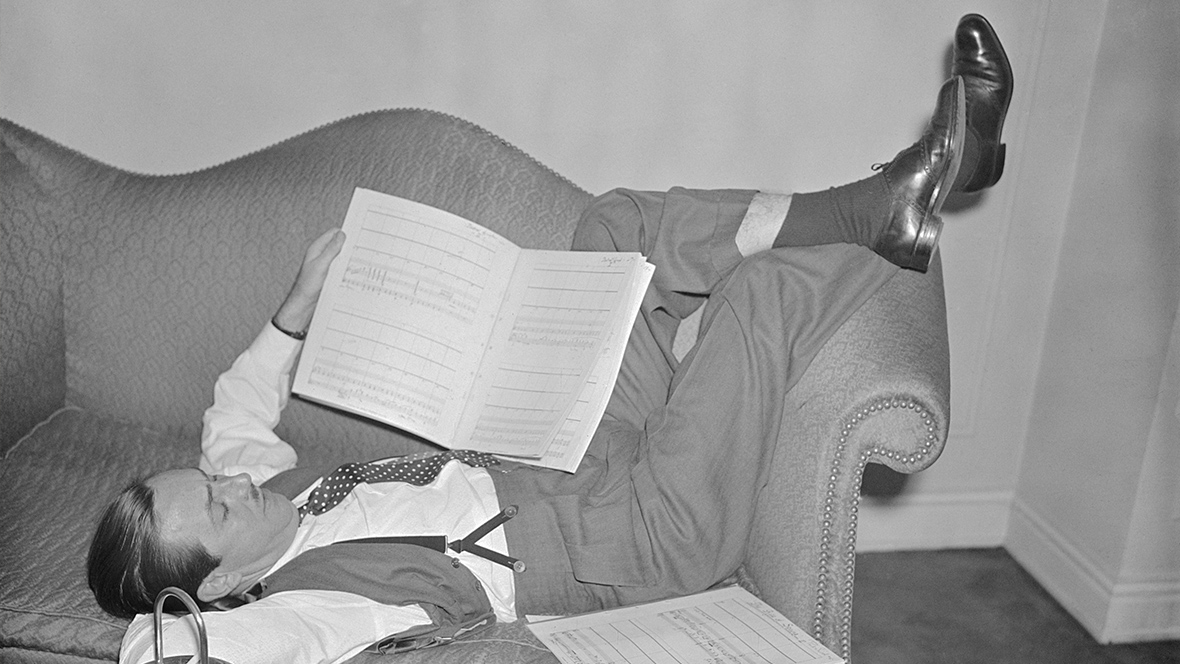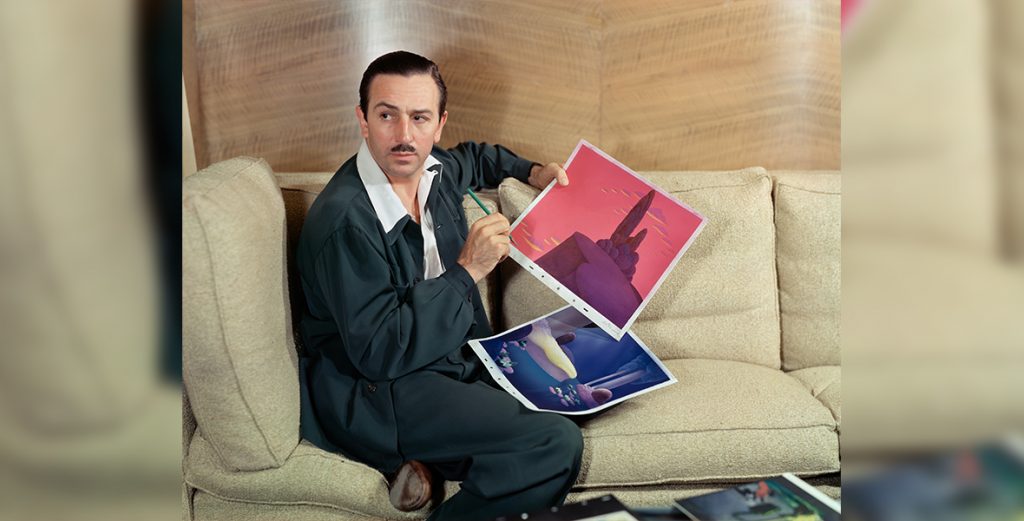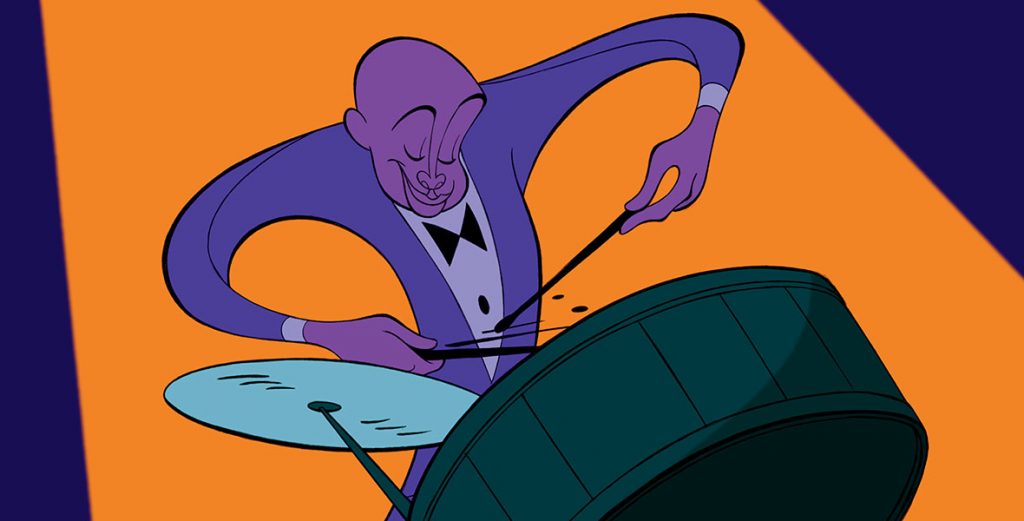By Jim Fanning
Walt listens to the Fantasia score being recorded at Philadelphia's Academy of Music in 1939, where nine "sound cameras" captured Stokowski and the Philadelphia Orchestra's magnificent performanes for Disney's award-winning Fantasound sound syste
With "music you can see and pictures you can hear," Walt Disney's Fantasia (1940) has been fascinating audiences for many years. As one of the most elaborate and lavishly produced animated features ever created, Fantasia has a symphony of behind-the-scenes stories swirling around it. So join in D23's celebration of Fantasia by conducting yourself through these fascinating facts about phenomenal Fantasia.
1. Dopey Might Have Been the Sorcerer's Apprentice
Once again it all started with a Mouse. Walt wanted to star Mickey in an animated version of The Sorcerer's Apprentice, and Fantasia evolved from that miniature musical. However, as Walt began developing an animated film based on Dukas's symphonic piece with Leopold Stokowski in 1937, Snow White and the Seven Dwarfs was on the verge of becoming a blockbuster, and it was suggested Dopey play the Apprentice instead of Mickey. Stokowski proposed another route: "What would you think of creating an entirely new personality for this film instead of using Mickey? A personality that could represent you and me You may have strong reasons for wishing Mickey to be the hero…. [But] I feel that if you create a new personality which represents every one of us, it might be a valuable factor in the years to come, and enlarge the scope. This is merely a suggestion… discard immediately if it does not interest you." Walt in fact did have strong reasons to star Mickey, not the least of which was that Mickey does represent "you and me" as a kind of "everyman" (or "everymouse"). Of course Mickey does portray the Apprentice (wearing a costume similar to Dopey's) in what has been acclaimed as one of his most brilliant animated performances. As veteran Disney director Ben Sharpsteen simply said decades later, "Mickey Mouse was, when you come right down to it… a good choice."
2. Stokowski Was a Superstar
The original 1940 theatrical poster reads "Walt Disney's Fantasia with Stokowski." Aside from distributors and the like, other people rarely shared billing with Walt on a Disney production's poster. Even more interesting is that the great conductor's billing is not "Leopold Stokowski" — instead, it's simply that one mighty name. In the history of art and entertainment, few have reached the point where one name says it all. Stokowski, you see, was more than a famous conductor — he was a superstar. The Maestro was famed for his masterful recordings and radio appearances from the late 1910s onward, but even those who seldom listened to classical music knew the name "Stokowski." His fame was such that he was featured on the April 28, 1930 cover of Time magazine. (Stokowski's second Time cover appearance was on the November 18, 1940 issue, as the conductor of Fantasia.) With his intense countenance, commanding stature and wild mane of hair ("He looks like Harpo Marx," commented Walt as he watched Stokowski conduct the Fantasia score), Stokowski was the very image of what many people envisioned when they thought of a "longhair" conductor. The charismatic orchestra leader was a natural for the silver screen, and the Maestro starred in the 1937 hits The Big Broadcast of 1937 (in which he conducts Bach's "Toccata & Fugue in D," also used in Fantasia) and One Hundred Men and a Girl (the "one hundred men" being Stokowski's Philadelphia Orchestra). So when Walt and Stokowski bumped into each other at a Hollywood hangout — Chasen's in Beverly Hills — a meeting of Maestro and Mouse-tro, filmmaking history would soon be made.
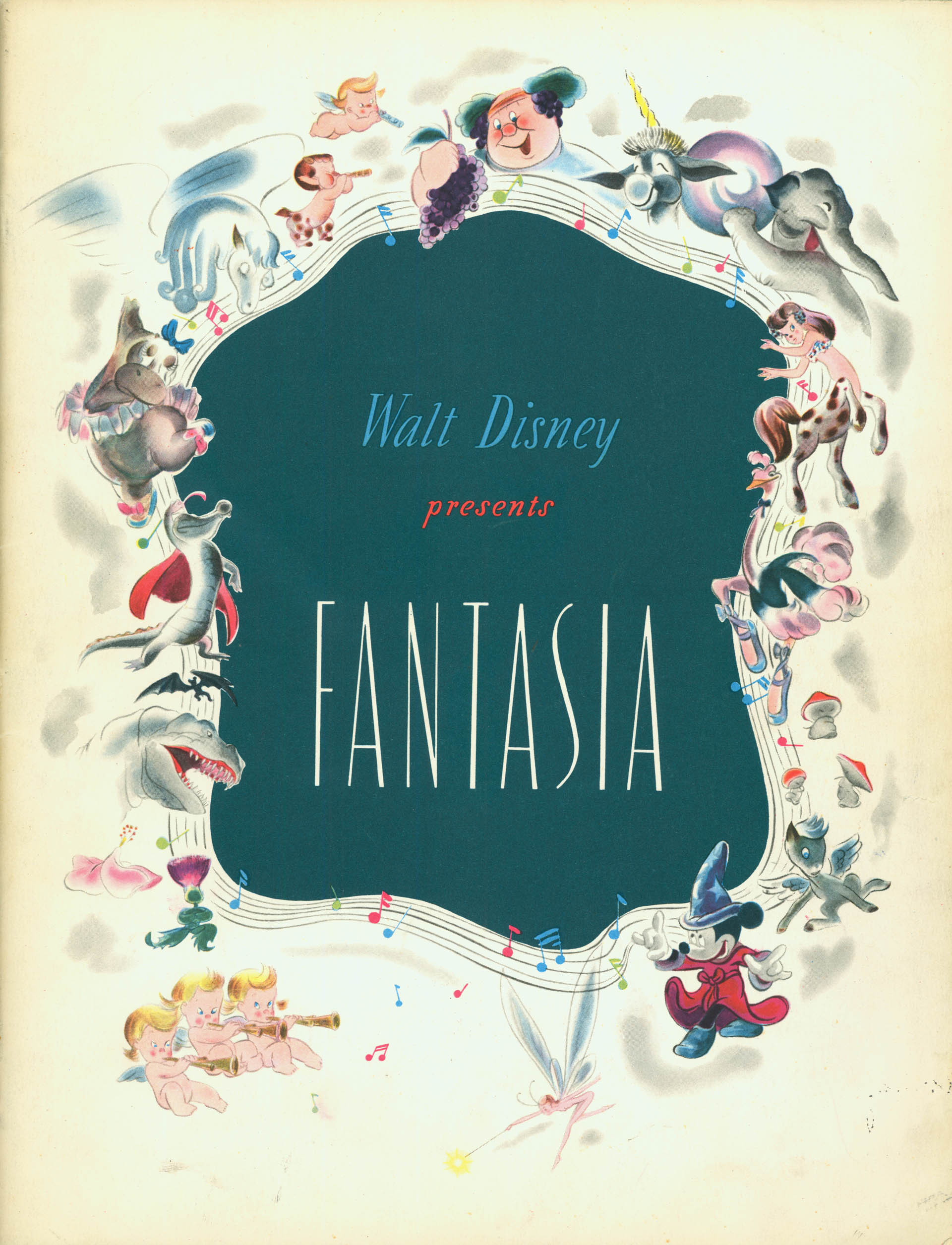
3. Dinosaurs Ruled the Screen
The animation for Stravinsky's "Rite of Spring" — considered a truly avant-garde work at the time of production — audaciously portrays Earth's formation and some of our planet's early inhabitants. Upon hearing the piece on September 13, 1938, Walt enthusiastically responded, "This is marvelous! It would be perfect for prehistoric animals." Paleontologists Barnum Brown of Manhattan's American Museum of Natural History and Chester Stock of California Institute of Technology were consultants, and pet iguanas and a baby alligator were brought to the Studio for the animator's inspiration. Woolie Reitherman, one of Walt's "Nine Old Men" and known for his vigorous action-oriented animation, animated the ferocious battle between the Tyrannosaurus Rex and the Stegosaurus. A similar scene was to be created for Walt's Magic Skyway attraction at the 1964-1965 New York World's Fair, the dinosaurs of which continue to thrill Disneyland Park guests at Primeval World along the Disneyland Railroad. Perhaps Walt gave the designers of the World's Fair dinosaurs the same direction he gave Woolie: "Don't make them cute animal personalities. They've got small brains, y'know; make them real!" For millions of Fantasia fans — including renowned Harvard paleontologist Stephen J. Gould — the "Rite of Spring" dinosaurs seem very real indeed.
4. Bela Lugosi Posed for "Night on Bald Mountain"
To inspire their animation, the Disney animators would sometimes enlist an actor to perform the characters, and for Fantasia's "Night on Bald Mountain," sequence, director Wilfred "Jaxon" Jackson brought in horror movie great Bela Lugosi to act out the evil actions of Chernabog, the god of evil for animator Bill Tytla. Most famous for his chilling performance as Dracula, Lugosi gave it his all, but Bill wasn't satisfied — so he had skinny Jaxon take off his shirt and perform as the muscular demon. Live-action was also used as inspiration for other Fantasia segments, such as for "Dance of the Hours." World-famous dancer Irina Baronova of the Ballet Theatre (now American Ballet Theatre) danced for the Disney artists, who created the ostrich ballerina they called Mlle. Upanova. (Incidentally, Bela Lugosi was portrayed by Martin Landau in his Oscar®-winning turn for Tim Burton's Ed Wood, released under Disney's Touchstone banner in 1994.)
5. The Fantasia Characters Have Little-Known Names
With the exception of musicologist Deems Taylor's narration (and a brief congratulatory exchange between Mickey and "Mr. Stokowski"), there is no spoken dialog in Fantasia, and perhaps that's why the names of its characters, such as Mlle. Upanova, are not generally known. In addition to Mlle. Upanova's balletic co-stars Hyacinth Hippo and Ben Ali Gator, there's little Hop Low (the film's original general release trailer termed him "the 'Dopey of the Mushrooms!"); Peter Pegasus, the black baby flying horse; and Bacchus's tipsy donkey Jacchus. Last but certainly not least, is the name of the mighty Sorcerer himself, Yensid. (If you're not sure what the name signifies, spell it backwards.)
6. Joe Grant Was a Creative Force on Both Fantasias
Disney Legend and Fantasia story director Joe Grant was part of the select group — the others were Walt, Stokowski, Deems Taylor, and co-story director Dick Huemer — who, during an intense few weeks in September 1938, selected the music to be included in what had originally been called The Concert Feature. Along with Huemer, conceptual/story artist Grant accompanied Walt to Philadelphia for the music recording, and he also guided the design of dozens of Fantasia players in his Character Model Department. For the "Ave Maria" segment, he suggested the forest resemble stained glass windows, a visual concept Joe found in his own backyard: "The trees in my yard had a Gothic form, which gave me the idea for the cathedral look." Incredibly, this beloved artist was also a vital contributor to Fantasia/2000, the original's long-awaited follow-up: Joe conceived the flamingo with a yo-yo storyline for the "Carnival of the Animals" sequence. As Joe said, with true Disney expertise, "There's always a good story in a good piece of music."
7. Walt Wanted Widescreen and More
Walt envisioned Fantasia as a sensory filmgoing experience — sight and sound to be sure, but Walt wanted more. He dreamed of producing this extraordinary film with extraordinary effects, such as 3-D for the "Toccata and Fugue" sequence and filming the entire movie in widescreen. The ever-innovative impresario even hoped to introduce olfactory effects, such as wafting perfume through the theatre as the wildflowers danced during the "Nutcracker Suite" segment, while Stokowski suggested gunpowder as a powerful scent for the Sorcerer's spell-casting. None of these concepts came to be for Fantasia, but Walt was proved a prophetic film producer, for widescreen and even "Smell-o-Vision" came into usage in the 1950s, as did 3-D — which is enjoying a resurgence in popularity today, as with Tangled, now in release in Disney Digital 3-D.
8. Fantasound Made a Splash
Among his other accomplishments, Stokowski was a pioneer in sound recording, and he was a proponent of a special sound system for Fantasia. Always an innovator, Walt Disney was also in favor of groundbreaking sound recording/reproduction for his experimental epic, as he desired to raise the live sound sensations of a concert hall to even greater heights. As Walt said: "Fantasia, to me is a whole new opportunity. For my medium it opens up unlimited possibilities. Music has always played a very important part since sound came into the cartoon. Now, the full expression that comes from the new Fantasound opens up a whole new world for us." The music was recorded on Stokowski's turf, the acoustically perfect Academy of Music, home of the Philadelphia Orchestra. Huge trucks hauled lineally tons of recording equipment to Philadelphia, where nine separate optical tracks were recorded, isolating various sections of the orchestra. This was mixed down to three main tracks with a special additional notched track (known as the TOGAD or tone-operated gain-adjusting device track), used to trigger relays for transferring the music to the many Fantasound speakers throughout the theater. Time reported: "The music comes not simply from the screen, but from everywhere; it is as if a hearer were in the midst of the music. As the music sweeps to a climax, it froths over the proscenium arch, boils into the rear of the theatre, all but prances up and down the aisles." Later, beginning in 1967, Fantasound was used by Disney's prestige record label, Buena Vista, for a sophisticated line of classical and Broadway musical score albums, as well as a "second cast" recording of Disney's own The Happiest Millionaire, released that same year.
9. Fantasia Earned Not One But Two Academy Award® Honors
On February 26, 1942, the Motion Picture Academy of Arts and Sciences honored Fantasia at its annual Oscar® ceremony. The Board of Governors voted to present the revolutionary motion-picture-and-music meld two Special Awards, both presented by Academy president and 20th Century Fox mogul Darryl F. Zanuck. The first went to Walt and the developers of Fantasound for "outstanding contribution to the advancement for the use of sound in motion pictures through the production of Fantasia." The second was presented to Stokowski "and his associates for their unique achievement in the creation of a new form of visualized music in Walt Disney's production of Fantasia, thereby widening the scope of the motion picture as an art form." That same evening Walt became the fourth producer ever to receive the Irving G. Thalberg Memorial Award, occasionally given for consistent creativity and excellence in production. The previous Thalberg honoree, David O. Selznick presented the award, and while it was for Walt's body of work and not Fantasia specifically, he praised the groundbreaking Disney feature "in which established music was used as the complete basis for the creation of the picture" which "contributed to the musical education of the public."
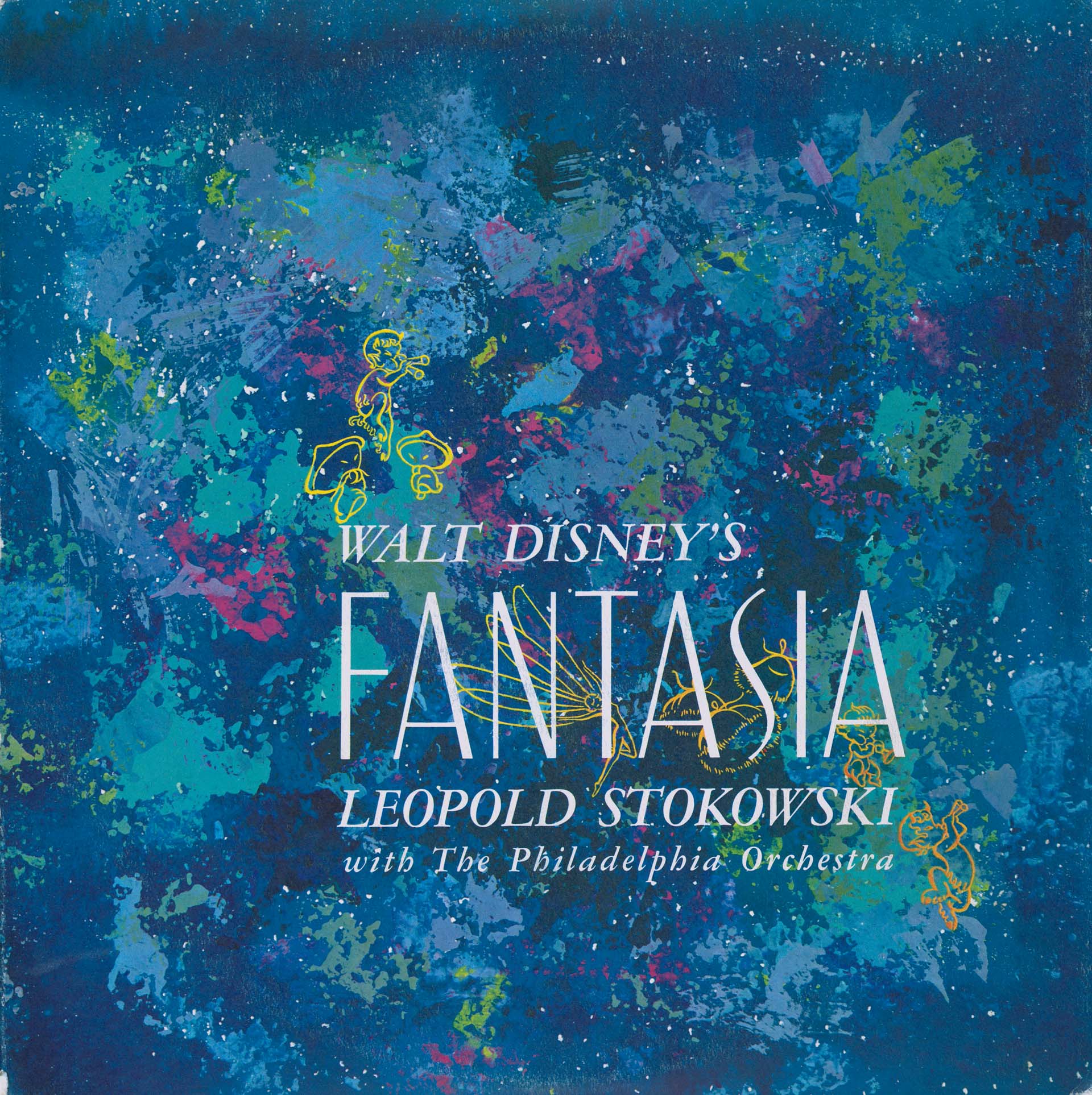
10. The Fantasia LP Album Set Stereos Spinning
A Fantasia soundtrack recording was not released until 1957, after the formation of Disneyland Records (now known as Walt Disney Records) in 1956. A deluxe three-LP record set with a 24 page insert book with text by Deems Taylor and illustrations adapted from the film by Disney animation artists Al Dempster, Dick Kelsey and Art Riley, all of whom worked on the film. In penning an introduction to this unique album set, Walt Disney noted that many fans had requested the Fantasia music be released as a recording. "To those who thrilled to... Fantasia, this album will recall many thrilling and delightful moments. We recommend that the volume control on your phonograph be kept at a moderate room level for the fullest enjoyment. The quality and dynamic range of the original recording has been preserved as carefully as possible so that the thunderous vigor of "Bald Mountain" and the delicate beauty of the "Nutcracker Suite" will be heard in their proper perspective. It will be immediately apparent to critical stereophonic enthusiasts that this by no means represents modern stereophonic recording, and no such claim is made. Nevertheless, we feel that this album will provide rich musical enjoyment to countless listener…" Indeed, many owners of stereophonic equipment were thrilled with the Fantasia LPs, for in emulating the Fantasound experience, the sound effectively bounced back and forth between the two speakers, thus assuring listeners their stereos actually worked. In 1991, Stokowski's Fantasia soundtrack was released on compact disk, selling about 100,000 copies that year alone. (Classical recordings selling one-tenth that amount are considered runaway successes). That CD set was reissued in 2001, and today, in keeping with Fantasia's tradition of innovation and cutting-edge technology, the film's revered soundtrack album is available on iTunes.
11. Walt Disney Showcased Fantasia on Television
Because of World War II and the impossibility to obtain the now-government rationed electronic equipment for Fantasound, Fantasia failed to recoup its high costs at the box office. "I don't regret making it," stated Walt in 1951. "It's what we should have been doing with our medium at that time." It was in the 1950s that Walt — ever aware of Fantasia's artistic merit — found a new showcase for the extraordinary film: television. To this day, Fantasia has never been shown on television in its entirety, but Walt used various segments of the spectacular film to good effect. In the very first episode of his weekly TV hour, The Disneyland Story (originally broadcast on October 27, 1954), Walt presented "The Sorcerer's Apprentice" as a tribute to Mickey Mouse. Other examples include "Tricks of Our Trade" (February 13, 1957) in which Walt used "Night on Bald Mountain" to demonstrate the power of great music, and "Magic and Music" (March 19, 1958), which featured the "Pastoral Symphony." Even though these early TV episodes were telecast in black-and-white, the colorful artistry of Fantasia shone through.

12. Fantasia was a Psychedelic Hit in the 1960s
Long before Blu-ray and instantly streaming movies, segments of Fantasia were available to schools in the 1960s as 16mm rentals, and university students rediscovered the film, finding the animated feature's overwhelming imagination and endless creativity mind-blowing. Catering to the hip kids who turned on to the artistry of Fantasia, Disney re-released the film for the fifth time in 1969, complete with a psychedelic ad campaign. Fantasia at long last turned a box office profit as audiences flocked to the theaters. In 1980, Disney Legend Irving Ludwig, who had managed Fantasia's 1940 roadshow engagements and returned to Disney to become President of Buena Vista Distribution in 1959, remarked: "Walt was at least 25 years ahead of his time and the public wasn't ready for Fantasia just yet. In 1969, however, the 18- to 30-year-olds finally discovered it — the very audience we had been wooing all the time. Since then it has been in continuous release in selected theaters across the country. Fantasia will always be my all time favorite picture."
13. Walt Wanted Fantasia to Continue
Walt's dream was to turn Fantasia into an ongoing event, stating in 1941, "it is our intention to make a version of Fantasia every year." Several months earlier in a letter to Stokowski Walt wrote: "From all the talk I hear in and around New York about Fantasia, I think if we put in one new number, almost everyone would go to hear the whole picture again. Then a few months later if we put in another new number, most of them will go again." From January through August 1941, Walt and his team developed story material based on eight additional pieces including Wagner's "The Ride of the Valkyries," von Weber's "Invitation to the Dance" and Rimsky-Korsakov's "Flight of the Bumblebee." Walt's dream of a Fantasia with new segments was finally realized in 1999 with Fantasia/2000, a spectacular follow-up spearheaded by Walt's nephew, Disney Legend Roy E. Disney.
14. Fantasia Played at the Carthay Circle Theatre
In 1940, Fantasia played exclusively at 13 select theaters, most of which were legitimate theaters rather than movie houses, including the Majestic in Boston and the Geary (now the American Conservatory Theater) in San Francisco. The two movie theaters were New York's Broadway and the prestigious Carthay Circle Theatre in Los Angeles. The Carthay Circle was celebrated as the site of some of Hollywood's most glittering premieres, not the least of which was Snow White and the Seven Dwarfs on December 21, 1937. A replica of the illustrious Carthay Circle will be the shining new centerpiece of the Disney California Adventure Park's in-progress renovation, a symbol of Walt's Hollywood triumphs, including Fantasia.
15. Fantasia Premiered in the Same Theatre as Steamboat Willie
As if to highlight the artistic peak to which Mickey had ascended, Fantasia's gala premiere was held at the theatre formally known as the Colony where, 12 years ago almost to the day, the Mouse had made his debut in Steamboat Willie on November 18, 1928. Describing it as "the greatest thrill of [Mickey's] acting career," Walt explained that Fantasia's debut "happened on the night of November 13, 1940 at the Broadway Theatre in New York City, the same theatre where he had made his first appearance as a ragged shoeless Mouse [more than] 10 years before." In just 12 short years, Mickey went from a primitive black-and-white steamboat to the dazzling heights of Mt. Olympus. Decades ahead of its time, Fantasia remains the art of Disney animation's pinnacle. With typical humility, Walt summed up amazing Fantasia more simply: "Perhaps Bach and Beethoven are strange bedfellows for Mickey Mouse, but it's all been a lot of fun."


